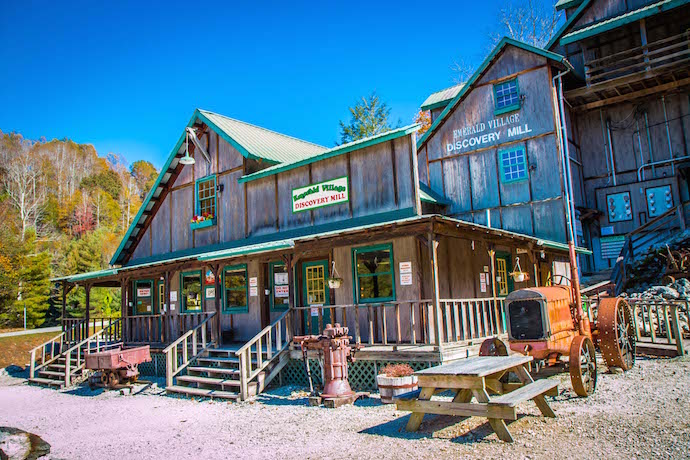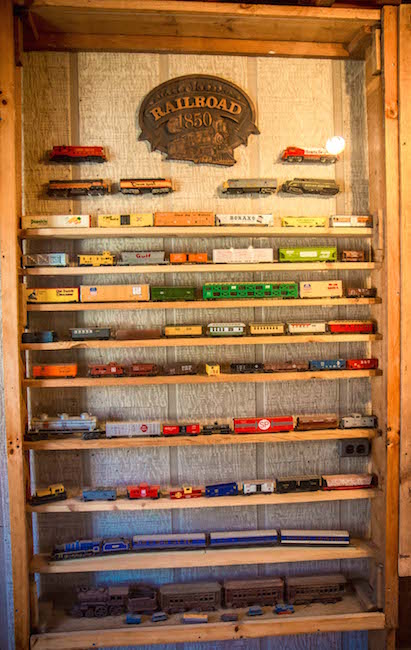Emerald Village is located just 31 miles from Asheville and three miles off the Blue Ridge Parkway.
The family-friendly attraction proved to be one of our favorite things to do in Little Switzerland NC, one of our favorite little tourist towns in the state.
Featured on shows such as National Geographic Channel’s The Savage Line and Travel Channel’s Ultimate World Access, the complex offers a family-friendly immersion in NC mining history.
The campus includes a visitor center, the North Carolina Mining Museum, the quirkily Discovery Mill building, 12 real mines (including one you can take a tour of), and numerous opportunities to try your luck at gem mining and gold panning.
Read on for our in-depth guide to everything there is to see and do at Emerald Village, including a brief history of gem mining in NC and info on the best places to visit.
READ MORE: Little Switzerland NC, Cutest Town on the Blue Ridge Parkway

EMERALD VILLAGE GEM MINES INFO
HISTORY OF EMERALD VILLAGE & GEM MINING IN NC
Gem mining in North Carolina dates back to 1799, when a 12-year-old boy named Conrad Reed found a 17-pound rock in Little Meadow Creek (east of modern-day Charlotte).
It was the first documented gold find in the United States, and it launched the nation’s very first gold rush. In the 1800s, gem mining in NC employed more local residents than any industry aside from agriculture.
The area that is now Emerald Village didn’t emerge as a hotbed for gem mining until nearly a century later, when a feldspar mine was discovered in 1886 (before the town of Little Switzerland NC was even built).
Feldspar is “a large group of rock-forming silicate minerals that make up over 50% of Earth’s crust.” They’re found in igneous, metamorphic, and sedimentary rocks all across the world.
Feldspars have a wide variety of uses. Albite (a.k.a. soda spar) is often used in glass, ceramics, paints, and plastics. Some types are sold as gemstones, such as Amazonite, Moonstone, and Sunstone. Others are used for interior and exterior building slabs.
READ MORE: The 15 Best Fairs in North Carolina to Visit

But the most famous product created from feldspar mining in North Carolina was Bon Ami cleanser.
Made with feldspar from the Bon Ami Mine, the household cleanser became very popular in the 20th century because it didn’t scratch surfaces and used no chemicals.
By 1926, Little Switzerland mining engineer Pete Deal had begun operations in the Big Deal Mine just down the street. A typical day involved drilling holes in rocks, blasting them with explosives, then hauling the feldspar to the mill for a return of about $6 per ton.
In 1960, a huge collapse left the Big Deal Mine’s equipment covered in a million tons of rock. The equipment owner left the business entirely, and by 1965 all mining operations had ceased.
Today, the Emerald Village complex is home to 12 different mines, as well as the North Carolina Mining Museum’s historic mining equipment, 10 levels of exhibits at Discovery Mill, and opportunities to try your luck at gem mining and panning for gold.
READ MORE: The 20 Best Western NC Small Towns to Visit (& Live In)

Gem Mining & Gold Panning at Emerald Village
Emerald Village offers four different options for those who want to try their hands at gem mining or gold panning in North Carolina.
They also have professionals on site who can cut and polish your gems into beautiful jewelry, for a unique souvenir of your time at the Little Switzerland attraction.
Crabtree Emerald Mine
One of only two significant NC Emerald mines, the Crabtree Emerald Mine produced Emeralds for companies like Tiffany’s from 1895 until its closure in the 1990s.
Although the mine shaft is now flooded, the extensive dumps around it have produced some impressive finds for gem miners in recent years.
For $20 a day, ages 13+ can get a digging permit to use hand tools and keep whatever they find. Emerald Village also rents tools for $25 per day.

McKinney Mine Dumps
Closed to gem collectors for 30+ years, Emerald Village reopened the McKinney Mine Dumps (once the largest feldspar mine in the world) so rock hounds can dig for native stones.
It’s hard work, but over 100 different types of minerals and gems have been found there, from Amazonite and Aquamarine to Garnets, Smoky Quartz, and Tourmaline.
Rates for digging permits and tool rentals are the same as for Emerald mining.
Gold Panning at Gemstone Mine
There are lots of “tourist trap” imitators in the area, but authentic gem mining in North Carolina doesn’t get any better than Emerald Village’s “Gemstone Mine.
It’s located in the entrance to the Big Deal Mine, where visitors can pay anywhere from $10 to $500 for a bucket filled with rocks, each of which may contain 25+ different types of gems.
Then they sit at one of two covered flumes of cold mountain spring water, sifting through ore from local mines. Rough gems are also added from other mines, ensuring a “Gem Find Every Time” so that guest get their money’s worth.
For the same price you can also try your luck at Gold-panning, using ore from North Carolina Gold mines that have been producing for 100+ years.
They teach you how to pan and provide the necessary gear. They also add small Gold nuggets and/or flakes to ensure that everyone finds a little something.
READ MORE: The 10 Best Blue Ridge Parkway Hikes for NC Day Trips

The NC Mining Museum & Bon Ami Mine Tours
Located just across the road from the Big Deal Mine and Discovery Mill, the NC Mining Museum offers an excellent overview for anyone interested in the history of Emerald Village and other North Carolina mines.
There are tons of antique mining equipment on display here (much of it covered in varying degrees of rust) that was actually used in the Little Switzerland mines.
For an $8 entrance fee, you can also take a self-guided underground tour of the famous Bon Ami Mine.
It allows you to get a closer look at the walls of the longtime feldspar mine, and provides a great view of the Bon Ami waterfall (just outside the mine entrance).
Visit the adjacent Company Store for a look at the small town back in the 1920s. And check out the Emerald Village website for dates for their special guided Black Light Mine Tours ($15 per adult), which offer a rare glimpse of the mine lit via UV lamps after dark.
READ MORE: The 27 Best Waterfalls Near Asheville NC

Exploring Discovery Mill
One of the most unusual and intriguing attractions at Emerald Village is Discovery Mill, which offers 10 levels of unique exhibits in a sprawling building overlooking the Gemstone Mine.
Starting in the Crabtree Junction Shop (which offers snacks, sweets, and souvenirs) on the bottom level, the free attraction seems to get more eclectic the higher you climb.
These photos will introduce you to a few of the major highlights, from the brilliant (see: the blacklight display of gems from local mines) to the bizarre (see: a Museum Annex full of enough old junk to give Fred Sanford heart palpitations)…

Native American Artifacts
Rightly pointing out that Native Americans were the original inhabitants of Western North Carolina, this display includes a variety of arrowheads, spear tips, and other ancient artifacts from the centuries when the Cherokee people ruled this region.

The Legend of the Miner’s Daughter
Appalachian culture loves a good ghost story. This display pays tribute to Ellie Jo Crabtree, a young girl orphaned when her daddy died in a local mine.
The gems he left her made her a wealthy woman for life, but her restless spirit supposedly haunts the Emerald Village mines in search of her father to this day!

NC Wildlife Taxidermy
One of the more inexplicable exhibits at Discovery Mill, this taxidermy display depicts two Bobcats fighting over a Wild Turkey.
There’s not really much of a background story to go along with it, which only makes the whole thing even more endearingly weird!

Clinchfield Model Railroad
Starting in the 1800s, the Clinchfield Railroad ran coal through the Blue Ridge Mountains, from Kentucky and Virginia to mills in the Carolinas.
This extensive exhibit includes two display cases filled with model railroad pieces.
There’s also an elaborate reproduction of the Clinchfield Loops, an engineering marvel of horseshoe curves in the North Carolina mountains.
Pianos & Junk in the Antique Music Museum
While most of the Discovery Mills exhibits were clearly constructed with an artful, some rooms of the Antique Music Museum and Homestead Museum are filled with an amalgam of junk.
From wall-to-wall, floor-to-ceiling, these rooms are a hoarder’s dream and a neat freak’s nightmare.
But it’s all part of what makes Emerald Village the most intriguing attraction in Little Switzerland, North Carolina! –by Bret Love; all photos by Bret Love & Mary Gabbett






